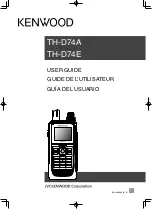
100/180 MM GRAPHICS RECORDER: USER GUIDE
User Guide
Page 57
HA261742
Issue 16 Nov 04
Adaptive trace
Actual input signal
Normal trace
Max/Min
bar
4.3.2 GROUP CONFIGURATION (Cont.)
GROUP NUMBER
For recorders with Multiple Groups fitted, this allows a particular group to be selected for configuration. Otherwise,
only Group 1 is available.
TREND UNITS
Allows mm/hr or inches per hour to be selected for the 'chart' speed. Automatically converts the trend speed field
below.
DESCRIPTOR
Allows the group name to be edited. See
section 3.3.1
for text entry techniques.
TREND TYPE
For recorders with 32MByte DRAM only (see System/About -
), this allows the selection of Adaptive
Recording for vertical and horizontal trend modes. The purpose of adaptive recording is to ensure that rapid, short
duration spikes (for example), are represented on the 'chart' even at low trend speeds. This allows the user to extend
the total amount of history stored in the recorder (by using slow trend speeds) without losing transient data.
The adaptive recording method works by measuring the input signal at the normal 125msec period, and saving the
maximum and minimum values, continuously, over the period of trend update. When the trend is updated, both maxi-
mum and minimum values are traced on the chart - i.e. two traces are produced for each channel in the group.
The faceplates and pen positions are still updated every second, as normal.
Notes:
1
During the period between updates, the maximum and minimum values are shown on the trend as a
horizontal line just beneath the pen, where the ends of the line represent the minimum and maximum
values so far. This line is removed at trend update time.
2.
Adaptive recording takes twice as much memory as normal recording, so an increase in the total amount
of history stored, occurs only if the trend speed is reduced to less than half of that which would normally
be used.
3.
In Trend History mode, both minimum and maximum values for the cursor position are shown on the
faceplate. See
for a description of trend history
Figure 4.3.2b shows the difference between normal and adaptive recording, at slow trend rates. Note that rapid
changes in signal, (such as those shown in the circled area of the 'actual signal') are largely filtered out by Normal
Tracing, but is displayed by the Adaptive Trace. Figure 4.3.2b is for illustrative purposes only, as traces such as these
could never appear on the chart together.
Figure 4.3.2b Adaptive recording compared with Normal tracing
















































